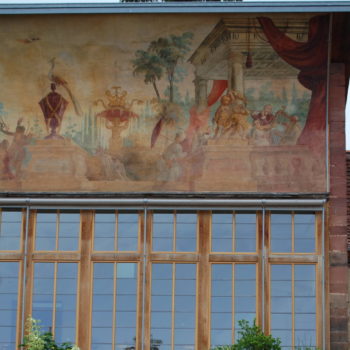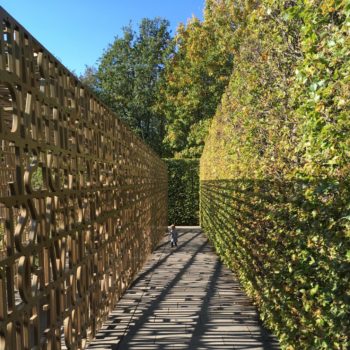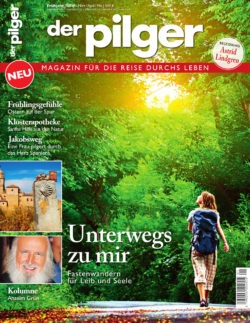“Recharge your batteries at Reute Monastery! Come and have a look.” These are the welcoming words used by the Sisters of St. Francis to invite us to their monastery in Reute, a small village near Bad Waldsee in Germany. Its location outside the village is the perfect place to recharge your batteries for daily life while enjoying a view over the open landscape dotted with fields and meadows. Depending on the season, lavender raises its fragrant flower spikes in the gentle breeze, or the majestic mullein, which can grow two meters high, stretches out towards the sun. In between, there is sufficient space for a few rows of rhubarb, peonies and phlox used by the monastery’s bakery or church. Cushions of thyme stand between rows of marigolds, their scents competing with that of peppermint.
Carefully sown and harvested by hand
“The areas where we grow our herbs are all bio-certified. Their breeding and care are all done by hand, as well as the harvest, of course,” says Sister Birgit, the herbalist of the nursery at Reute Monastery. The older sisters, now retired and living in Reute, are called upon to help when the time comes to harvest and dry the herbs. With a great deal of patience, love and attention, they pluck the petals of flowers, such as marigolds. This work in a historic garden hall is carried out in a meditative mood, in a calm and quiet atmosphere. The monastery’s products are sold in the store, where the visitor can choose from six different herbal teas, an herbal salt made from a variety of 15 spice plants or a pepper blend refined with colourful petals.
The true speciality of the women religious, however, is the garden dedicated to cultivating medicinal plants: They are growing in four different beds distributed over a square area and have healing effects on various organs and functions of the body. This garden is a true showcase of horticultural skills. Additional beds contain plants for use in women’s medicine, spices such as those grown by the Sisters for their herbal teas, or plants described in the Bible. They are all labelled so the interested visitor can pause on the paths or meadows to study the different herbs and learn about their growth, leaves and flowers. The selection of plants, however, might surprise some of the garden lovers with stinging nettle, ground elder and ground ivy. “Pest plants” that many home gardeners would weed out with a hoe, a spade or a garden fork. Here, in the pharmacy garden of Reute Monastery, they are cultivated on purpose. “Many things that bother us in our home garden could actually be helpful,” says Sister Birgit. And she even goes further: “In fact, what helps us is exactly the same as what we find in our surroundings.”
There are several steps in herbal medicine that can be of help, all of which the nun observes for herself in case of illness: “You have to consider what is good for you, then go out and find it, harvest it, prepare it, and finally apply or take it. It is most important to look at things very closely. After all, this opens me up to the help concealed inside the plants. As important as it is to take your time for each of the steps.”
Exotic herbs from mission stations
Another herb bed is dedicated to the classic “Hildegard’s Healing Plants”. The herbs growing here include galangal, balm, pellitory and many others, all of which were used and recommended by Saint Hildegard of Bingen in the Middle Ages. This does not mean that the Sisters of St. Francis are not open to new developments. Jiaogulan from East Asia is one example of their latest horticultural activities. Also called “immortality herb” in some regions, one might be inclined to accuse this wild climbing plant used for healing and salads of being trendy. But in fact, it is used in traditional Chinese medicine and has been known as a healing plant in the Far East for almost seven centuries. “Natural and botanical medicine is a miracle, with a huge variety of plants that can actually help us,” says Sister Birgit. The Sisters of Reute Monastery also draw their knowledge from the various mission stations of the order in Brazil or Indonesia. Nuns brought medicinal plants from overseas to the German region Upper Swabia, such as the “Holy Leaf” or life plant, whose leaf juice has an anti-inflammatory and pain-relieving effect, and is flourishing in many pots, protected from the German winters in the sisters’ greenhouse. Sister Birgit is a renowned expert for medicinal herbs. She gives guided tours, which vary according to the season and familiarize visitors with the plants of the monastery. For the woman of faith, this and her seminars on herbs have one primary goal:
“When our visitors return home, they should see their own garden and nature’s diversity with different eyes. It is my hope that I can inspire them to do so.” The plant-loving Sister is always willing to learn something new during her guided tours: “I am really happy when visitors are sharing their experiences with plants with me.” And this is not only out of professional curiosity. “What Creation has to offer us is something that amazes me again and again.”
God gave us the earth to till it and keep it
Love and gratitude towards Creation, its animals and plants, was already important to the founder of the Order, Francis of Assisi, 700 years ago. Sometimes, he is referred to as the “first environmentalist of the world”. Francis and his friends were convinced: God gave us the earth, that is why we should tend it and care for it like a good gardener. According to Francis of Assisi, there should always be space for wild herbs and field flowers in the monastery garden, which provided food for the monastic community. Francis’ Canticle of the Sun says:
“Praised be You, my Lord, through Sister Mother Earth, who sustains us and governs us and who produces varied fruits with coloured flowers and herbs.”
The labyrinth as a pilgrimage to the soul
The origins of Reute Monastery date back to 1403 when five women moved into the “cell” existing at this place. The nuns according to the rules established by Francis of Assisi. Elizabeth Achler (1386–1420) from Bad Waldsee was one of them and held in high esteem during her own lifetime as a mystic and a humble woman of the people. She was beatified in 1766 and is also known today as “Elizabeth the Good”.
Reute Monastery was dissolved in 1784 as a result of the state’s expropriation. But today, almost 150 years have passed with women of the order living here again. For them, Elizabeth the Good is a role model of a modest monastic life, which, at the same time, opens itself to the people outside. After all, the Sister’s commercial activities are not limited to horticulture only. They also run several other handicrafts businesses, such as a butcher shop, a bakery for altar bread, and an embroidery shop for paraments where ecclesiastical vestments are produced. The monastery is a destination for pilgrims who come to visit the Baroque parish and pilgrimage church to see the tomb of Elizabeth the Good and the “Gut-Betha-Brunnen”, a fountain named after her.
The tour through the medicinal herb garden of Reute Monastery always ends with a special invitation: With its “Labyrinth of the Senses”, the flower garden that is part of the monastery area welcomes visitors to discover and praise the beauty of Creation. It is an impressive place during summer when the magnificent pulchritude of summer flowers, ornamental grasses and decorative perennials unfolds. “Walk slowly and pay attention to what you hear and feel, what you see and smell,” are the words of Sister Birgit inviting us to a heedful walk through the labyrinth.
In early Christianity, such labyrinths were regarded as “pilgrimages to the soul”. The winding paths lead to a central point, they help the pilgrim to find oneself and the way to God. Small panels with spiritual aphorisms accompany this journey to oneself in Reute. Benches welcome visitors to linger and contemplate while unwinding. “The labyrinth gifts us with a time to focus and regain our vigour. Eventually though, we will have to leave, get back to our daily routine,” explains Sister Birgit. To live in harmony with nature means “to retreat for a while, to recharge your batteries and to walk on with new strength”.
Lesen Sie weitere Beiträge zum Thema Klostergärten
Beitrag

History of the monastery garden
Beitrag

Monastery gardens as working spaces and symbolic sites
Beitrag



